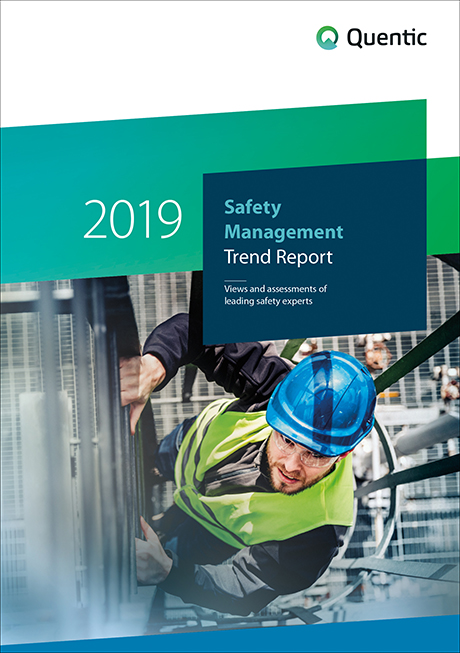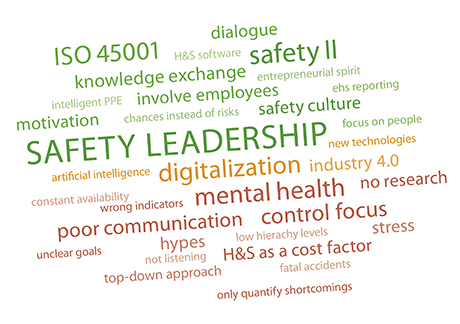What challenges and success factors reform workplace safety? From ISO 45001 and Behavior Based Safety to smart Personal Protective Equipment: In Quentic’s Safety Management Trend Report 2019, leading experts from 8 countries discuss what will shape the occupational safety of the future.
The world of work is changing. Industry 4.0 is bringing people and technology closer together than ever before. Companies are working more globally, more flexibly and with more automation. But are they also working safer? When it comes to digitalization, occupational safety still rarely stands at the forefront. But the potential is enormous: for a field of tasks that affects an entire organization, data is the foundation of any smart company.
How digitalization is changing occupational safety
The experts Quentic questioned for the Safety Management Trend Report are all sure of one thing: New technology is permanently changing occupational safety. Artificial Intelligence, EHS software and smart Personal Protective Equipment offer new ways to protect employees. But digitalization is not just bringing opportunities. The phenomena of constant availability and increasingly blurred boundaries between work and personal life constitute mental health risks, which need to be duly considered and mitigated.
Motivating managers and employees
The biggest challenge foreseen by the experts asked lies in motivating all members of a company for workplace safety. Leadership is required! ISO 45001, the international standard for management systems of occupational health and safety, emphasizes management commitment to proactively improve safety performance. To establish a goal-driven safety culture, leaders need to foster long-term motivation in their employees. The level of occupational safety in a company can only develop positively when executives listen to, encourage and involve their employees in the long term. Due to this, approaches such a Behavior Based Safety (BBS) are gaining in popularity, especially in an international context. Emerging movements like Safety II and Safety Differently also see the classic top-down approach as increasingly outdated. They are also questioning the numeric “Zero Accidents” goal.
Different approaches united in one report
So, do skilled workers need to rethink? Or are these new approaches merely old wine in new bottles ? Quentic purposefully joins together different schools of thought in the Safety Management Trend Report 2019. Occupational safety specialists and EHS managers will get a good overview of current movements, trends and success factors. The experts who have contributed to this report include professors, association members, consultants and representatives with practical experience. The entire qualitative report can be downloaded at www.quentic.com/safety-trends-2019.
Press pictures
Cover picture of the Quentic Safety Management Trend Report 2019
- RGB | 1,7 MB | JPG | Source: Quentic - picture: istock.com/Portra
- CMYK | 2,5 MB | JPG | Source: Quentic - picture: istock.com/Portra
Tag cloud expert statements: Trends and challenges in occupational safety
QR-Code: Download the Quentic Safety Management Trend Report 2019 here for free
Excerpts from the Safety Management Trend Report
Which trends deserve special attention this year?
“The increasing popularity of wearable devices and smart PPE, with sensors that moni-tor workers activity in real-time, collect biometric data, and measure signs of poor health. Savvy safety professionals have begun turning to technology and the Internet of Things (IoT) to improve workplace health and safety. Smart PPE is definitely an im-portant trend to watch.”
David Cant
Director of Veritas Consulting Safety Services
In which areas has occupational safety failed?
“Traditional metrics focus on quantifying failure (the number and rate of accidents) and trying to encourage us to fail less. This is demotivating at best and destructive at worst; it encourages non-reporting, misclassification of accidents and other, more devious ways of thwarting the system.”
Professor Andrew Sharman
Professor of Leadership and Safety Culture at the European Centre for Executive Development (CEDEP) on the INSEAD Campus in France and CEO of RMS Switzerland
What are the biggest challenges in 2019?
“The challenge is to inspire and motivate people to lead with safety. To help senior managers to practice genuine and visible safety leadership, enhancing the soft skills of the HSE professionals’ community.”
Davide Scotti
Head of the Corporate HSE Culture, Communication & Training department at Saipem and and General Secretary of the LHS Foundation
Which developments have particularly improved occupational safety?
“I am convinced that behavior-based safety (BBS), when implemented correctly, is one of the most successful developments in safety management. However, too many or-ganizations have taken a quick-fix approach to BBS by eliminating its most critical ele-ment: effective, interpersonal, supportive and corrective behavior-based feedback. The letters of COACH say it all: C for Care, O for Observe, A for Analyze, C for Com-municate, and H for Help.”
Professor E. Scott Geller
Alumni Distinguished Professor and Director of the Center for Applied Behavior Systems at Virginia Tech and Senior Partner of Safety Performance Solutions, Inc.
Who is one of the most influential people in this field?
“The impact of Andrew Hale's work on the worldwide safety discipline is very much underestimated and underappreciated. But currently there are no thought leaders who I would avidly follow online. Many of the current 'names' are making a lot of hys-terical noise and promoting untested strategies in an attempt to overcome an appar-ently dreadful culture of blame. Their arguments are dangerous, unproven tautologies that could lead practitioners astray from proven safety management strategies, result-ing in a lot more SIFs.”
Dr. Dominic Cooper
CEO of BSMS Inc.
About Quentic
Quentic is one of the leading Software as a Service solution providers in the European EHS and CSR market. The company is headquartered in Berlin, Germany, and employs more than 200 people. Quentic maintains branch offices in Germany, Austria, and Switzerland, as well as in Belgium, Finland, Denmark, and the Netherlands. Over 600 customers strengthen their EHS and CSR management with Quentic software solutions. With eight combinable modules, the online platform handles Health & Safety, Risks & Audits, Hazardous Materials, Legal Compliance, Online Instructions, Processes, as well as Environmental Management and Sustainability. The solution is suitable for management systems according to ISO 14001, ISO 50001, and ISO 45001. It is Quentic’s mission to connect, engage, and inspire all EHS and CSR stakeholders – via browser or app. Quentic supports seamless cooperation across departments, locations, and even countries, thereby helping companies coordinate all processes efficiently and in compliance with legal requirements.

